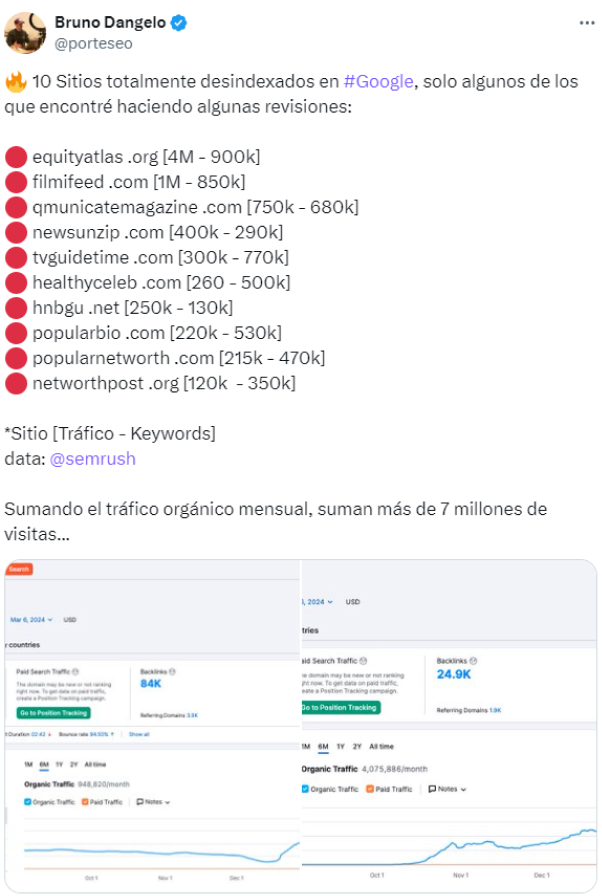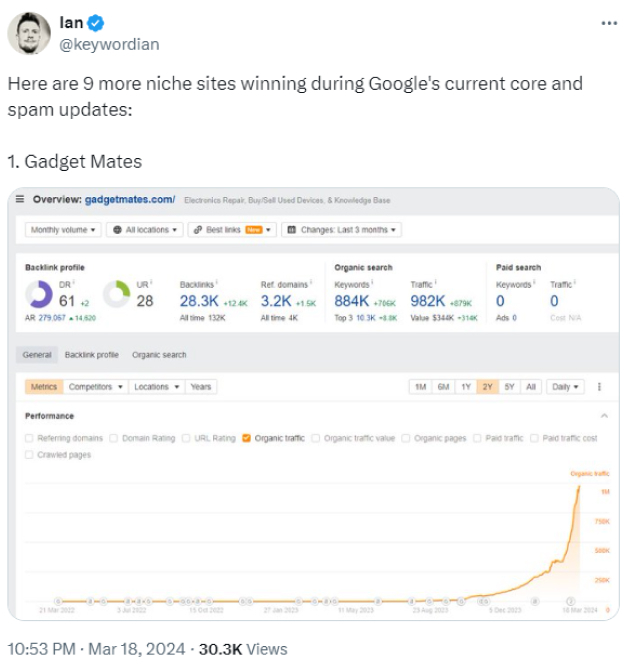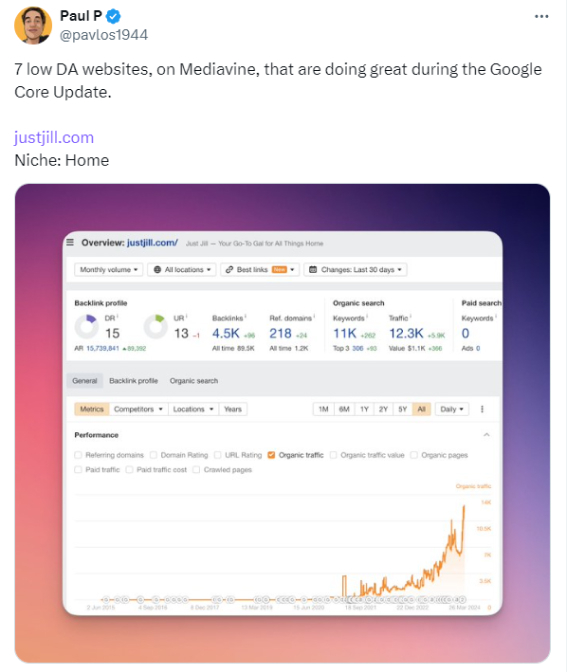10000
•
8-minute read


The big and scary Google March 2024 update made a splash among SEOs. Many websites experienced fluctuations in rankings; some faced penalties for spammy tactics and complete site deindexing, while others saw unexpected boosts.
Today, I'll explain all the intricacies of this update and devise a recovery strategy for businesses striving to return visibility in search results after the Google March 2024 update.
Google is fine-tuning its ranking systems to spot pages that aren't really helpful or user-friendly (yes, again). They want to ensure users get content that's genuinely useful, not just stuffed with keywords to attract search engines.
With this update, Google is aiming to prevent the use of spammy tactics used to game the system. The main focus is on mass-produced or sneaky third-party content. Overall, Google is planning to reduce the appearance of low-quality content in search results by 40%.
But that's not all. Google's also cracking down on scheming like using expired domains or abusing reputable sites to boost search rankings. Google wants to keep things fair and ensure that people see only trustworthy and relevant search results.
Here is what Google says on the matter:
Today we're announcing key changes we're making to improve the quality of Search and the helpfulness of your results:
Improved quality ranking: We're making algorithmic enhancements to our core ranking systems to ensure we surface the most helpful information on the web and reduce unoriginal content in search results.
New and improved spam policies: We're updating our spam policies to keep the lowest-quality content out of Search, like expired websites repurposed as spam repositories by new owners and obituary spam."
It seems that the recent update is quite intricate. There were two updates that were released on the 5th of March: one is spam and the other is a core update. The Google March 2024 core update was done rolling out on April 19th (45 days after the release day), while the spam update was completed two weeks after its release.
So, how volatile was the Google March 2024 core update? The volatility was drastic. Some sites even got manual action for "pure spam":
Some sites were completely deindexed:

Fun fact: John Mueller's official website was also deindexed during the core update rollout. Was John trying to manipulate search results? John Mueller actually addressed this concern in his own manner.
Some sites faced big drops in rankings:

Meanwhile, many sites from different niches benefitted from this update:

Even sites with low Domain Authority saw a crazy boost:

The general statistics were not long in coming. The first clearly arranged results were collected by Lili Ray through Sistrix Visibility Index:
Surprisingly, Wikipedia suffered the most from this update. Dictionaries and health organizations were also among the victims. So, either all those sites appeared to be bad guys, or Google's algorithms aren't as reliable as Google staff and we want them to be.
In general, Google has been harsh on updates over the last year. Do you remember the September 2023 Helpful Content update? Many sites lost their positions back then. By the way, Glenn Gabe checked how the March 2024 core update affected those who suffered from the update in September 2023. The results: most sites dropped even further.
So, if your sites dropped in September, be cautious and check your site performance now.
To check if your website has been affected by the Google March core update, you need to look out for a few key indicators: manual actions, rankings, traffic, and indexed pages. For a full picture, I suggest using two tools: Google Search Console and Rank Tracker. Below, I explain how.
The fastest and most reliable way to check if your site was affected by the Google March 2024 core update is to use Google Search Console.
First thing, you’ll need to check if your site’s got the most weighty penalty – manual action.
In Google Search Console, go to Security & Manual Actions > Manual Actions and check for notifications. If everything is good, you'll see the No issues detected message.
If you see notifications like Pure spam, expand the description panel in the report for more information. Then, check which pages are affected.
See the type and short description of the issue, and follow the Learn more link to see detailed information and steps to fix the problem.
To check organic clicks and impressions in Google Search Console, click on the Performance report (Search Results). Here, you need to select the appropriate date range and review the data for changes in clicks, impressions, click-through rate (CTR), and average position.
Pay attention to any significant fluctuations — they may signal effects stemming from the core update.
To see which pages got fewer visits and how much they dropped, go to Pages and compare clicks and impressions by date:
You should also check indexing issues in case some important pages have disappeared from the index.
To check indexed pages in Google Search Console, go to Indexing > Pages. Review the report to ensure that all important pages are indexed. Look for any errors or warnings related to indexing, such as crawl errors or blocked pages.
You'll need to address indexing issues promptly to ensure your site's content is fully accessible to search engines.
It will be more convenient and insightful to check rankings and historical changes in organic traffic in Rank Tracker.
Launch Rank Tracker and create a project for your site by entering the domain and specifying your target keywords.
Make sure to connect your Google Analytics account in the Preferences section:
Then, go to Rank Tracking > Tracked Keуwords and switch to the Organic Traffic tab in the lower part of your dashboard.
The dotted lines over your graph mark the dates of major Google algorithm updates. Examine the graph to see if any drops in traffic correlate with the updates.
You can also switch to the Rank Progress tab and check how your rankings differ from your previous check, as well as estimate the SERP features you might have lost or gotten.
So, you've checked the impact of the update on your website's traffic, rankings, and overall performance, and you didn't like what you saw.
Now, you need to be patient. Your performance may go back to normal in a matter of a few days without any effort involved. However, if nothing changes in days, it is likely you’ll have to make significant adjustments to your website's content, structure, and overall SEO strategy to return to past success.
So, if the Google March core update did get your site, you’ll need to return Google's trust in it. Here are some steps you can take to recover from Google's March 2024 core update:
Compile a list of pages that have experienced a drop in rankings or traffic following the core update. Use tools like Rank Tracker or Google Search Console to identify these pages and prioritize them for optimization.
Focus on improving the quality of your content. Ensure that your articles, blog posts, product descriptions, and other content pieces are valuable, relevant, and comprehensive.
Update your site pages so that they no longer violate Google's spam policies. Pay special attention to the following:
Revise and update poor-quality content to make it unique and useful. If something can’t be improved, consider removing it from your site entirely. For example, if you have no resources for content updating, or the scale of affected pages is too large.
If you use the expired domain and publish low-quality content there in the hope that the domain's high authority will do the job, I've got bad news for you. Even if you improve all the content there, it probably won’t help much. Google will penalize your site anyway.
It will be more beneficial for you to get a new domain instead and fill it with quality content.
Note: If you use other black-hat techniques, such as cloaking, sneaky redirects, or parasite SEO, you’d better stop. Google March update will probably catch you red-handed and penalize your site.
Audit your backlink profile to identify any low-quality or spammy backlinks pointing to your site. Use SEO SpyGlass to analyze your backlinks:
Focus on enhancing the experience, expertise, authoritativeness, and trustworthiness (E-E-A-T) of your website.
Provide clear author credentials, cite credible sources, and ensure accuracy and reliability in your content. Incorporate user feedback, testimonials, and reviews to build trust with your audience.
Additionally, improve the overall user experience of your site by optimizing site speed, mobile responsiveness, and navigation.
If you got a Manual Action, you’ll need to request a review of your site once you’re done with the fix.
When you're sure your site is no longer violating Google spam policies, select Request Review in the Manual Actions report. Provide examples of bad content that you removed and good content that you added.
After you submit a reconsideration request, be patient and watch for review status messages in your Search Console account. The Google team will let you know when they've reviewed your site. If they decide that your site is no longer violating Google spam policies, they'll revoke the manual action.
Note: If a manual action has not been applied to you, and you are simply updating the site pages one by one, don’t forget to request a reindex in Google Search Console when everything is ready. This way, Google picks up the changes faster and your rankings will be back sooner.
If you just lost a little in traffic, then make improvements, and probably soon (in a matter of days), you will be able to regain your positions.
If you were thrown out of the index or received a manual action, then, of course, it will be a completely different story. Here, you may have to completely rethink your SEO approaches. And it may take time.
And given that Google churns out updates quite often, it's essential to continuously monitor your site's performance and make necessary adjustments timely to adapt to evolving search algorithms.
Keeping up with Google's latest updates can be tricky, but there are ways to reduce their impact on your website and keep it at the top of search results. It's important to keep an eye on any changes and improve your site to stay visible and relevant.
How is your site doing during the Google March 2024 core update? Share your stories in our user group on Facebook.

